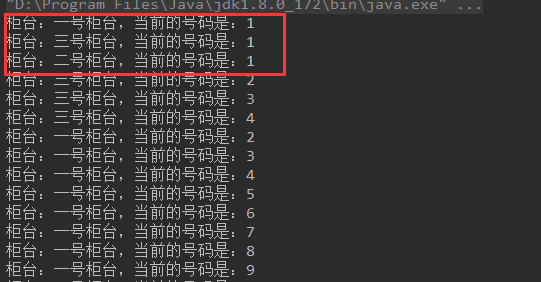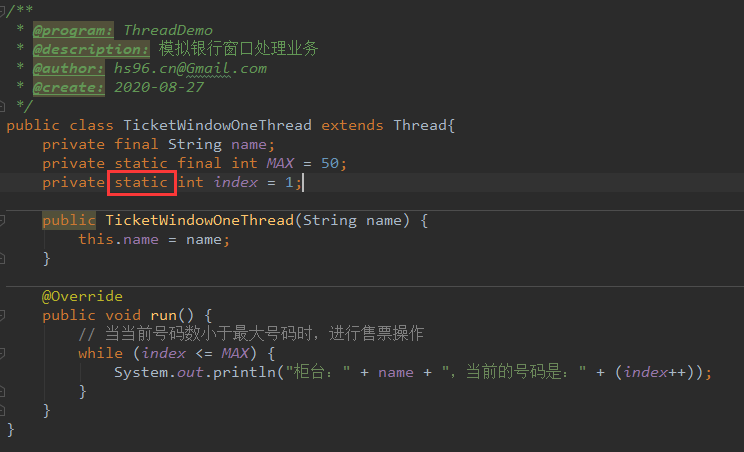# 采用多線程模擬排隊叫號
關于排隊叫號想必大家都了解:比如去銀行,都會有取號機,銀行窗口每辦理完一個業務都會叫下一個排隊的號去處理業務,一個人不會被多個窗口同時叫號,所以這里也涉及到了一個多線程共享數據的問題:我們先用代碼簡單模擬一下流程:
```java
/**
* @program: ThreadDemo
* @description: 模擬柜臺
* @author: hs96.cn@Gmail.com
* @create: 2020-08-27
*/
public class Bank {
public static void main(String[] args) {
TicketWindowOneThread ticketWindowOneThread = new TicketWindowOneThread("一號柜臺");
ticketWindowOneThread.start();
}
}
```
```java
/**
* @program: ThreadDemo
* @description: 模擬銀行窗口處理業務
* @author: hs96.cn@Gmail.com
* @create: 2020-08-27
*/
public class TicketWindowOneThread extends Thread{
private final String name;
private static final int MAX = 50;
private int index = 1;
public TicketWindowOneThread(String name) {
this.name = name;
}
@Override
public void run() {
// 當當前號碼數小于最大號碼時,進行售票操作
while (index <= MAX) {
System.out.println("柜臺:" + name + ",當前的號碼是:" + (index++));
}
}
}
```
運行效果如下:

這個輸出毫無疑問,目前是單線程動作,接下來模擬三個窗口來模擬下真實的銀行處理過程:
```java
/**
* @program: ThreadDemo
* @description: 模擬柜臺叫號
* @author: hs96.cn@Gmail.com
* @create: 2020-08-27
*/
public class Bank {
public static void main(String[] args) {
TicketWindowOneThread ticketWindowOneThread1 = new TicketWindowOneThread("一號柜臺");
ticketWindowOneThread1.start();
TicketWindowOneThread ticketWindowOneThread2 = new TicketWindowOneThread("二號柜臺");
ticketWindowOneThread2.start();
TicketWindowOneThread ticketWindowOneThread3 = new TicketWindowOneThread("三號柜臺");
ticketWindowOneThread3.start();
}
}
```
運行結果如下:

這時候每個柜臺都按照自己的號來叫,也就是窗口的index沒有在線程之間同步,那么如何解決呢?
其實也很簡單:只要用static修飾一下就好了:

運行效果如下:

可以看到三個線程已經實現共享`TicketWindowOneThread`的`index`了。但是可以看到輸出的順序顛倒了,這個我們后續再優化,先理解這個線程共享資源的概念即可。
- 微服務
- 服務器相關
- 操作系統
- 極客時間操作系統實戰筆記
- 01 程序的運行過程:從代碼到機器運行
- 02 幾行匯編幾行C:實現一個最簡單的內核
- 03 黑盒之中有什么:內核結構與設計
- Rust
- 入門:Rust開發一個簡單的web服務器
- Rust的引用和租借
- 函數與函數指針
- Rust中如何面向對象編程
- 構建單線程web服務器
- 在服務器中增加線程池提高吞吐
- Java
- 并發編程
- 并發基礎
- 1.創建并啟動線程
- 2.java線程生命周期以及start源碼剖析
- 3.采用多線程模擬銀行排隊叫號
- 4.Runnable接口存在的必要性
- 5.策略模式在Thread和Runnable中的應用分析
- 6.Daemon線程的創建以及使用場景分析
- 7.線程ID,優先級
- 8.Thread的join方法
- 9.Thread中斷Interrupt方法學習&采用優雅的方式結束線程生命周期
- 10.編寫ThreadService實現暴力結束線程
- 11.線程同步問題以及synchronized的引入
- 12.同步代碼塊以及同步方法之間的區別和關系
- 13.通過實驗分析This鎖和Class鎖的存在
- 14.多線程死鎖分析以及案例介紹
- 15.線程間通信快速入門,使用wait和notify進行線程間的數據通信
- 16.多Product多Consumer之間的通訊導致出現程序假死的原因分析
- 17.使用notifyAll完善多線程下的生產者消費者模型
- 18.wait和sleep的本質區別
- 19.完善數據采集程序
- 20.如何實現一個自己的顯式鎖Lock
- 21.addShutdownHook給你的程序注入鉤子
- 22.如何捕獲線程運行期間的異常
- 23.ThreadGroup API介紹
- 24.線程池原理與自定義線程池一
- 25.給線程池增加拒絕策略以及停止方法
- 26.給線程池增加自動擴充,閑時自動回收線程的功能
- JVM
- C&C++
- GDB調試工具筆記
- C&C++基礎
- 一個例子理解C語言數據類型的本質
- 字節順序-大小端模式
- Php
- Php源碼閱讀筆記
- Swoole相關
- Swoole基礎
- php的五種運行模式
- FPM模式的生命周期
- OSI網絡七層圖片速查
- IP/TCP/UPD/HTTP
- swoole源代碼編譯安裝
- 安全相關
- MySql
- Mysql基礎
- 1.事務與鎖
- 2.事務隔離級別與IO的關系
- 3.mysql鎖機制與結構
- 4.mysql結構與sql執行
- 5.mysql物理文件
- 6.mysql性能問題
- Docker&K8s
- Docker安裝java8
- Redis
- 分布式部署相關
- Redis的主從復制
- Redis的哨兵
- redis-Cluster分區方案&應用場景
- redis-Cluster哈希虛擬槽&簡單搭建
- redis-Cluster redis-trib.rb 搭建&原理
- redis-Cluster集群的伸縮調優
- 源碼閱讀筆記
- Mq
- ELK
- ElasticSearch
- Logstash
- Kibana
- 一些好玩的東西
- 一次折騰了幾天的大華攝像頭調試經歷
- 搬磚實用代碼
- python讀取excel拼接sql
- mysql大批量插入數據四種方法
- composer好用的鏡像源
- ab
- 環境搭建與配置
- face_recognition本地調試筆記
- 虛擬機配置靜態ip
- Centos7 Init Shell
- 發布自己的Composer包
- git推送一直失敗怎么辦
- Beyond Compare過期解決辦法
- 我的Navicat for Mysql
- 小錯誤解決辦法
- CLoin報錯CreateProcess error=216
- mysql error You must reset your password using ALTER USER statement before executing this statement.
- VM無法連接到虛擬機
- Jetbrains相關
- IntelliJ IDEA 筆記
- CLoin的配置與使用
- PhpStormDocker環境下配置Xdebug
- PhpStorm advanced metadata
- PhpStorm PHP_CodeSniffer
